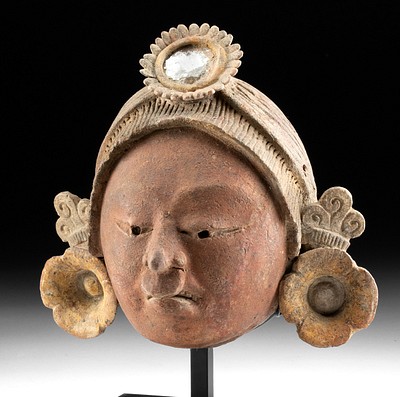19th C. Russian Lukutin / Fedoskino Lacquered Eggs
Lot 176d
About Seller
Artemis Fine Arts
686 S Taylor Ave, Ste 106
Louisville, CO 80027
United States
Selling antiquities, ancient and ethnographic art online since 1993, Artemis Gallery specializes in Classical Antiquities (Egyptian, Greek, Roman, Near Eastern), Asian, Pre-Columbian, African / Tribal / Oceanographic art. Our extensive inventory includes pottery, stone, metal, wood, glass and textil...Read more
Categories
Estimate:
$1,500 - $2,250
Absentee vs Live bid
Two ways to bid:
- Leave a max absentee bid and the platform will bid on your behalf up to your maximum bid during the live auction.
- Bid live during the auction and your bids will be submitted real-time to the auctioneer.
Bid Increments
| Price | Bid Increment |
|---|---|
| $0 | $25 |
| $300 | $50 |
| $1,000 | $100 |
| $2,000 | $250 |
| $5,000 | $500 |
| $10,000 | $1,000 |
| $20,000 | $2,500 |
| $50,000 | $5,000 |
| $100,000 | $10,000 |
| $200,000 | $20,000 |
About Auction
By Artemis Fine Arts
Jul 14, 2022
Set Reminder
2022-07-14 10:00:00
2022-07-14 10:00:00
America/New_York
Bidsquare
Bidsquare : Exceptional Antiquities Ethnographica Fine Art
https://www.bidsquare.com/auctions/artemis-gallery/exceptional-antiquities-ethnographica-fine-art-9692
Museum-worthy examples of classical antiquities (Egyptian, Greek, Roman, Near Eastern), Viking, Far East / Asian, Pre-Columbian, African / Tribal, Oceanic, Native American, Spanish Colonial, Fossils, Ancient Jewelry, Fine / Visual Arts, so much more! Artemis Fine Arts info@artemisfinearts.com
Museum-worthy examples of classical antiquities (Egyptian, Greek, Roman, Near Eastern), Viking, Far East / Asian, Pre-Columbian, African / Tribal, Oceanic, Native American, Spanish Colonial, Fossils, Ancient Jewelry, Fine / Visual Arts, so much more! Artemis Fine Arts info@artemisfinearts.com
- Lot Description
Eastern Europe, western Russia, near Moscow, Fedoskino, likely Lukutin Factory, ca. second half of the 19th century CE. A gorgeous pair of papier-mache lacquer eggs, both finely painted with religious and stately scenes in vibrant hues and perforated with vertical drill holes. Enveloped in a lustrous shade of emerald, the larger egg displays a scene of Christ's Resurrection on one side and a lush floral motif on the other with gilt curlicues decorating the field. A slender rope has been strung through the drill hole, tied in a bow at each side and allowing the egg to be suspended. Alternatively, the more petite egg is coated in scarlet-colored pigment with the image of Saint Seraphim of Sarov on one side, while an Orthodox church adorns the other. Size (larger without rope): 2.8" Diameter x 4.2" H (7.1 cm x 10.7 cm); size (larger with rope): 2.8" Diameter x 8" H (7.1 cm x 20.3 cm)
This style of lacquer miniature painting on papier-mache is known as Fedoskino painting, named after an old village in Moscow where the tradition was centered starting in the late 18th century. As seen in these examples, Fedoskino painting is distinctive for the use of mother-of-pearl, gold, or silver leaf under segments of the background to create a shimmering glow or silvery sparkle as seen in these examples. Miniatures of this type from the second half of the 19th century are known as "lukutins"; taking their name from the Lukutin family who owned the Fedoskino factory at the time. Thus, even Fedoskino eggs that are not marked with the Lukutin family coat of arms can be referred to as "Lukutin." For example Christie's London referred to an unmarked egg that also bared images of Christ's Resurrection and the Kremlin as being by the Lukutin Factory in lot 303 in Live Auction 1161 "Important Russian Art" on November 24th, 2013.
According to the Dorich House Museum in London, "Production of lacquered papier-mache began with the pressing and forming of cardboard sheets which were then boiled in linseed oil and then baked in an oven. Thereafter the material could be worked like wood and artists could begin fine painting on the blank surfaces. Although Lukutin was focused primarily on producing goods for the upper classes and Vishnyakov looked more to the general population, a fierce rivalry had grown up between the two factories following Lukutin's takeover of the Korobov factory. Competition spurred innovation and the range of items produced was extended to include brooches, tea caddies, spectacle cases, the aforementioned Easter eggs, and other items."
Provenance: private New Jersey, USA collection
All items legal to buy/sell under U.S. Statute covering cultural patrimony Code 2600, CHAPTER 14, and are guaranteed to be as described or your money back.
A Certificate of Authenticity will accompany all winning bids.
PLEASE NOTE: Due to recent increases of shipments being seized by Australian & German customs (even for items with pre-UNESCO provenance), we will no longer ship most antiquities and ancient Chinese art to Australia & Germany. For categories of items that are acceptable to ship to Australia or Germany, please contact us directly or work with your local customs brokerage firm.
Display stands not described as included/custom in the item description are for photography purposes only and will not be included with the item upon shipping.
#172570A few miniscule abrasions to each. Fraying and patina to rope of larger. Otherwise, both are intact and excellent with nicely preserved pigments.Condition
- Shipping Info
-
All shipping is handled in-house for your convenience. Your invoice from Artemis Gallery will include shipping calculation instructions. If in doubt, please inquire BEFORE bidding for estimated shipping costs for individual items.
-
- Buyer's Premium



 EUR
EUR CAD
CAD AUD
AUD GBP
GBP MXN
MXN HKD
HKD CNY
CNY MYR
MYR SEK
SEK SGD
SGD CHF
CHF THB
THB













